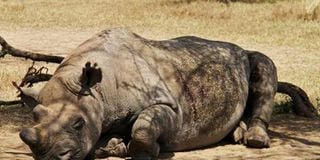Black rhino reintroduced in community conservancies in Samburu County

Baraka, the first black rhino to be born at the Ol Pejeta Conservancy in 1994. A new venture by KWS, the Northern Rangelands Trust and Lewa Conservancy will see black rhinos reintroduced in community conservancies in Samburu County. FILE PHOTO | NATION MEDIA GROUP
What you need to know:
- The new venture started on Monday is aimed at expanding the animals’ habitat in the country in order to boost the population of the species.
- At least 20 pre-selected rhinos will be moved from Lewa, Nakuru and Nairobi National Parks to a sanctuary operated by Sera Community Conservancy.
- Community rangers have been trained by Lewa and KWS in data gathering, anti-poaching operations, bush craft and effective patrolling.
- Populations of the Eastern black rhino (Diceros bicornis michaeli) plummeted by 98 per cent between 1960 and 1995 due to poaching.
Kenya Wildlife Service is reintroducing the endangered black rhinos back to community conservancies in Samburu, 25 years after the last of them was killed by poachers.
The new venture started on Monday is aimed at expanding the animals’ habitat in the country in order to boost the population of the species.
Other organisations participating in the venture are Northern Rangelands Trust and Lewa Conservancy.
At least 20 pre-selected rhinos will be moved from Lewa, Nakuru and Nairobi National Parks to a sanctuary operated by Sera Community Conservancy.
“This will be the first time in East Africa that a local community will be responsible for the protection and management of the highly threatened black rhino.
“It signals a shift in Kenya's conservation efforts,” Ms Sophie Harrison, a spokesperson for NRT said in a statement.
Two rhinos have already been successfully moved and released to their new home.
The ages of animals earmarked for translocation range from six-and-a-half to 20 years.
This is meant to reflect natural demographics and encourage natural breeding conditions.
All animals will be fitted with satellite-based transmitters for close monitoring.
COMMUNITY RANGERS TRAINED
Community rangers have been trained by Lewa and KWS in data gathering, anti-poaching operations, bush craft and effective patrolling.
They will be supported by anti-poaching units from Lewa, NRT and KWS.
Reintroduction of the rhinos to the habitat demonstrates the government’s confidence in the local community conservation efforts and is an indication of its commitment to supporting community-based conservation initiatives as provided for by the new Wildlife Act, 2013, Ms Harrison said.
The presence of the rhinos in Samburu County will significantly boost its tourism and residents look forward to new job opportunities as well as enhanced security.
Parts of the community conservancy will also be set aside grazing by local herders during the dry season, Ms Harrison said.
Populations of the Eastern black rhino (Diceros bicornis michaeli) plummeted by 98 per cent between 1960 and 1995 due to poaching.
However, conservation efforts have managed to stabilise and increase numbers in most of the black rhino’s former ranges since then.





